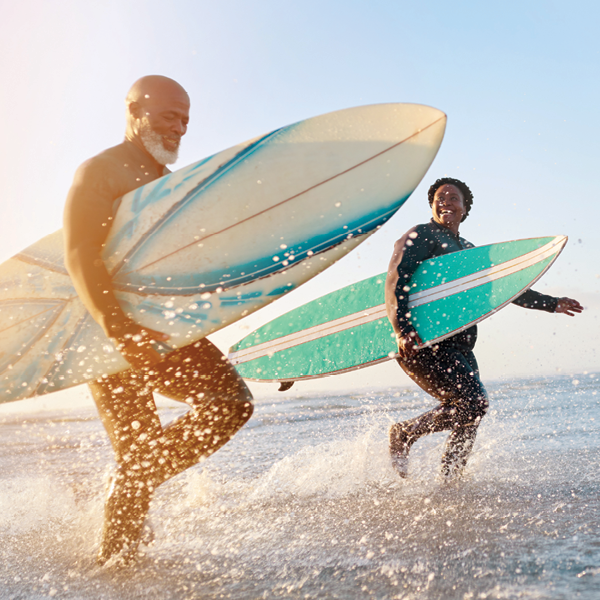This article was written by Robin Wielins, Au.D., a HearingLoss.com®-certified provider located at Island Audiology & Hearing Aid Centers in Oahu, Kauai, and Kona, Hawai’i.
If you love hiking, swimming, yoga, or cycling, you know how important it is for your gear to keep up with you. That includes your hearing aids. Today’s hearing technology is more advanced, more durable, and more tailored to real life than ever before. However, not all hearing aids are created equal when it comes to performance in dynamic environments.
This guide will walk you through the key features to look for when choosing hearing aids that support your active lifestyle, along with practical tips to get the most out of your devices in every setting.
Why Choosing the Right Hearing Aid for Your Lifestyle Matters
Whether you’re a weekend jogger or an everyday paddleboarder, the environments you move through present unique challenges for hearing aids. Wind, water, sweat, and sudden movements can all impact hearing aid performance. That’s why it’s essential to choose a device that’s designed with your lifestyle in mind.
Hearing care professionals see patients across the spectrum of activity levels. One common thread: when hearing aids are selected based on lifestyle as well as hearing needs, patients report higher satisfaction, better sound clarity, and more confidence in their daily routines.

Ready to Hear Every Adventure?
Your workouts, waves, and weekend hikes deserve gear that keeps up. Connect with a HearingLoss.com‑Certified provider for a personalized fitting and device recommendations built for movement, sweat, and every environment in between.
Key Features for Active Hearing Aid Users

1. Water Resistance and IP Ratings
Moisture is a top concern for active hearing aid users. Devices are now rated using the Ingress Protection (IP) scale, where the second number indicates water resistance.
- IP67 means the hearing aid can withstand sweat and brief water exposure.
- IP68 means it can endure extended submersion in water (though not for swimming).
While no hearing aid is truly waterproof, devices with IP68 ratings provide peace of mind for those exposed to rain, sweat, or high humidity. If you spend time near water, these are essential.
2. Secure, Comfortable Fit
Movement matters. A secure fit keeps your hearing aid in place while running, cycling, or doing yoga. Features to look for include:
- Retention locks or sports clips for added stability
- Open-fit or receiver-in-canal (RIC) designs for comfort
- Custom earmolds for personalized security and comfort
Even small design differences can dramatically affect how stable a hearing aid feels during motion.
3. Wind Noise Management
Wind can interfere with microphones, creating loud whooshing sounds that drown out voices or environmental cues. Many premium hearing aids now include:
- Directional microphones that focus on speech
- Wind noise suppression algorithms that reduce background interference
- Automatic environmental adjustments for seamless sound transitions
For cyclists and runners, wind noise control is not a luxury — it’s a necessity for safety and communication.
4. Durability and Shock Resistance
Hearing aids are small electronic devices, but that doesn’t mean they have to be fragile. Some models are built to withstand drops, dust, and sweat. Look for:
- Reinforced casing and nano-coating to protect internal components
- Dust-resistant design for hiking trails and outdoor adventures
A rugged build ensures your devices stay reliable no matter where your journey takes you.
5. Rechargeability and Battery Life
Long days outdoors can challenge hearing aid battery life. Fortunately, many modern prescription hearing aids offer advanced power options:
- Rechargeable batteries that last all day on a single charge
- Fast-charging cases for convenient top-ups
- Energy-efficient processing to reduce drain
You shouldn’t have to choose between hearing and enjoying your day. Reliable battery life makes that possible.
6. Bluetooth Connectivity
Bluetooth allows your hearing aids to connect to your phone, fitness tracker, or smart watch. That means:
- Hands-free calls and audio streaming during workouts
- GPS directions or music streamed right to your ears
This technology empowers you to stay connected, entertained, and in control, all while staying active.

Experience These Features in Real Life
Ready to feel the difference IP68 protection, wind‑smart microphones, and all‑day power can make? Connect with a HearingLoss.com‑Certified provider for a personalized consultation and discover hearing aids built for every adventure.
Everyday Scenarios: How the Right Hearing Aid Makes a Difference
Hiking on Windy Ridges
Without wind noise reduction, the sound of gusts can overpower conversations or environmental awareness. With the right technology, voices stay clear, and important sounds like approaching hikers or wildlife are easier to hear.
Swimming or Waterside Activities
While hearing aids shouldn’t be submerged, water-resistant models can handle the occasional splash. For activities like kayaking or lounging poolside, an IP68-rated device gives you more freedom and less worry.
Yoga and Strength Training
Movements like lying down or stretching can knock loose poorly fitted devices. A custom-molded hearing aid stays secure, letting you focus on form and breath instead of readjusting your equipment.
Cycling and Running
These environments come with a lot of air movement. Directional microphones and secure fits help block out wind and keep you connected to your surroundings.
How to Get Fitted for the Right Hearing Aid When You’re Active

Choosing the right hearing aid is only part of the equation — how it’s fitted and programmed matters just as much. For active individuals, a professional fitting ensures your hearing aids stay secure, perform optimally in varied environments, and are tailored to your unique hearing profile.
A proper hearing aid fitting often includes:
- Lifestyle assessment: Your provider will ask about your daily routines, physical activity, and listening environments to recommend the right features.
- Real-ear measurement (REM): This best-practice tool ensures your devices are programmed based on how sound actually behaves in your ear canal.
- Comfort and retention checks: Your provider may recommend custom earmolds, retention clips, or sports sleeves to ensure a snug fit during movement.
- Technology coaching: You’ll learn how to use Bluetooth features, manage moisture exposure, and make quick adjustments for different settings — like the gym, the beach, or the trail.
Getting a personalized fitting with a HearingLoss.com-Certified provider can dramatically improve your experience, especially if you live an active life. It’s the key to hearing aids that move with you — not against you.
Common Questions About Hearing Aids and Active Lifestyles
Does insurance cover prescription hearing aids?
Coverage varies widely depending on your provider and plan. Some insurance policies do cover or partially cover prescription hearing aids, particularly when medically necessary. Your hearing care professional can help you understand your benefits and navigate the process.
How long do prescription hearing aids last?
With proper care, most prescription hearing aids last 3 to 7 years. Regular maintenance and occasional reprogramming can extend their effectiveness.
Can I use hearing aids while working out?
Yes. In fact, many recent hearing aids are designed to handle the challenges of physical activity. Just be sure to select models with the features discussed above and keep them clean and dry after use.
Do I need special accessories for hearing aids during exercise?
Some users benefit from accessories like sweatbands, hearing aid sleeves, or sport clips to keep devices dry and secure during workouts. A hearing care provider can recommend options tailored to your lifestyle.
Are hearing aids waterproof or just water-resistant?
Most hearing aids are water-resistant, not waterproof. Devices with IP67 or IP68 ratings can withstand sweat and brief exposure to water, but they’re not designed for swimming or full submersion.
What should I do if my hearing aid gets wet?
Dry it immediately using a soft cloth and a hearing aid dehumidifier if available. Do not use a hair dryer or microwave. If the device stops working, schedule an appointment for professional cleaning or repair.
Your Hearing Should Support Your Lifestyle — Not Limit It
Whether you’re exploring oceanfront trails or joining a beach yoga class, the right hearing aid can bring clarity, connection, and confidence to every adventure.
Every ear is different, and so is every lifestyle. That’s why we take the time to understand your needs, answer your questions, and guide you toward hearing solutions that fit you — physically, technologically, and personally.
Questions? Island Audiology and HearingLoss.com are Here to Help
As a hearing care provider living and working in Hawai’i, I know how deeply sound connects us — to each other, to nature, and to daily life on the islands. That’s why I founded Island Audiology: to help people fully experience every ocean breeze, every conversation, every note of music with clarity and confidence.
At our practice, we’re committed to the highest standards of care. We use real-ear measurement during fittings and follow-ups to ensure your hearing aids are precisely tuned for your individual hearing profile. This attention to detail often makes the difference between just “hearing better” and truly reconnecting with the world around you.
That’s also why I’m proud to be part of the HearingLoss.com network. Every provider in this trusted community shares the same dedication to evidence-based practices and patient-first care. By partnering with HearingLoss.com, I’m not just supporting my own patients — I’m part of a larger mission to make high-quality hearing care more accessible, informed, and empowering.
Whether you’re just beginning your hearing journey or looking for long-term support, I encourage you to explore the valuable tools and resources at HearingLoss.com. And if you’re in Hawai’i, my team and I at Island Audiology are here to help you hear, and live, your best island life.
References
- Ingress protection (IP) ratings guide. (2020). IEC. https://www.iec.ch/basecamp/ingress-protection-ip-ratings-guide. Accessed June 18, 2025.
The Bluetooth® word mark and logos are registered trademarks owned by Bluetooth SIG, Inc. Any use of such marks by HearingLoss.com® or Island Audiology & Hearing Aid Centers is under license.
Island Audiology & Hearing Aid Centers wants you to be satisfied with your care. We are a local, independent, community-oriented practice. Our services are fully guaranteed, meaning we’re committed to listening to your concerns, and your technology is always perfectly fit to renew your world of hearing. A strong patient-provider relationship based on honesty, integrity, and values is what we strive for, and we feel that this is the best approach to making sure you don’t miss any of the precious moments in your life.


